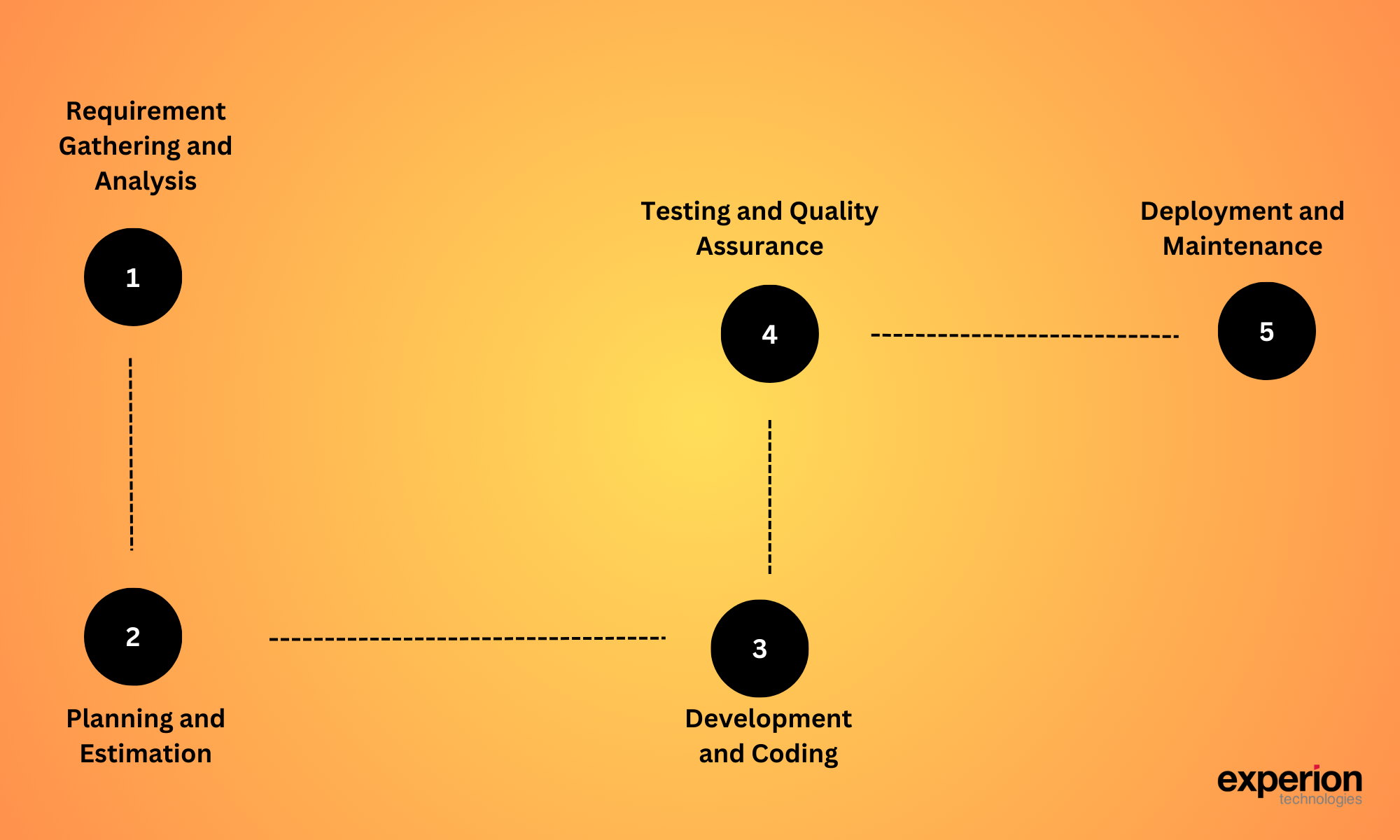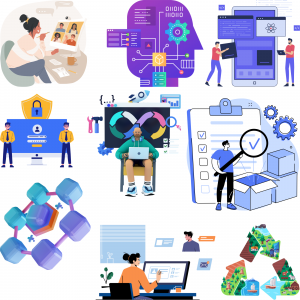 Experion’s offshore solutions have turbocharged countless success stories, delivering elite expertise and impressive cost savings that make waves in the industry. Global companies like Google and Microsoft have established offshore development centers in countries like India to tap into the vast pool of skilled IT professionals. From cost savings to access to specialized expertise, more and more businesses are embracing offshore development as a strategic advantage in 2024. When businesses are constantly seeking ways to expand their reach and stay competitive, strategic partnerships have become essential for success. From exploring new markets to accessing specialized skills, collaboration is the key to unlocking growth opportunities.
Experion’s offshore solutions have turbocharged countless success stories, delivering elite expertise and impressive cost savings that make waves in the industry. Global companies like Google and Microsoft have established offshore development centers in countries like India to tap into the vast pool of skilled IT professionals. From cost savings to access to specialized expertise, more and more businesses are embracing offshore development as a strategic advantage in 2024. When businesses are constantly seeking ways to expand their reach and stay competitive, strategic partnerships have become essential for success. From exploring new markets to accessing specialized skills, collaboration is the key to unlocking growth opportunities.
Offshore software development goes beyond mere cost-cutting; it’s a catalyst for innovation and efficiency. Companies are turning to offshore service providers not just for savings but for access to diverse talent and the agility to navigate market challenges.
In this blog, we’ll look at the potential of global collaboration and its effectiveness in terms of business growth. From the practical considerations of cultural differences to the strategic advantages of leveraging technology, we’ll explore how businesses can navigate gracefully through offshore software development to achieve their goals.
What is Offshore Software Development?
Offshore Software Development (OSD) refers to the practice of outsourcing software development tasks and projects to teams located in countries other than the client’s own. This method enables businesses to tap into a worldwide talent pool, frequently at a reduced cost compared to hiring locally or in-house. Offshore software development teams collaborate remotely with clients to design, develop, test, and maintain software applications and systems.
Offshore software development: Benefits and challenges
Cost-effectiveness
 OSD stands out for its ability to deliver substantial cost savings. Consider the following insights:
OSD stands out for its ability to deliver substantial cost savings. Consider the following insights:
- Reduced Labor Rates: According to a report by Deloitte, countries like India and the Philippines offer significantly lower rates for custom software development services compared to the United States or Europe, resulting in notable cost reductions.
- Reduced Overhead: Engaging in OSD allows companies to minimize infrastructure costs associated with maintaining an in-house development team, leading to substantial overhead reductions.
- Tax Advantages: Some researchers suggest that certain offshore destinations, such as Ireland and Singapore, offer attractive tax incentives for companies involved in offshore development activities, providing additional opportunities for cost savings.
Access to Global Talent Pool: Leveraging Diverse Skill Sets
 OSD unlocks access to diverse talent pools worldwide, offering unparalleled advantages:
OSD unlocks access to diverse talent pools worldwide, offering unparalleled advantages:
- Specialized Expertise: Expertise allows companies to tap into specialized talent pools, giving them access to skills that might be scarce locally. This advantage enables businesses to stay ahead in technological advancements and meet evolving industry demands.
- Diverse Perspectives: Offshore teams contribute diverse perspectives and innovative solutions to software development projects, fostering creativity and driving business growth. Their unique cultural backgrounds enrich problem-solving approaches and foster innovation, resulting in more robust and adaptable solutions that resonate with global audiences.
- Scalability: The global nature of OSD allows companies to scale their development teams rapidly in response to changing project requirements, ensuring flexibility and agility throughout the development lifecycle.
Time Zone Advantages: Maximizing Productivity and Efficiency
 Leveraging time zone differences strategically can significantly enhance productivity in OSD:
Leveraging time zone differences strategically can significantly enhance productivity in OSD:
- Continuous Development: Distributing tasks across different time zones enables teams to maintain a continuous development cycle, resulting in faster project delivery and reduced time to market.
- Faster Turnarounds: Leveraging time zone differences allows companies to expedite critical development phases and bug fixes by capitalizing on round-the-clock work cycles, leading to faster turnaround times and improved responsiveness.
- Streamlined Communication: Establishing clear communication protocols and utilizing collaboration tools facilitate seamless information exchange between onshore and offshore teams, overcoming time zone barriers effectively.
Nearshore vs Offshore vs. Onshore Software Development

Nearshore Development: Benefits and Limitations
Benefits:
- Reduced Time Zone Disparity: Communication flows more smoothly with minimal time zone differences, facilitating real-time collaboration and faster decision-making.
- Cultural Similarities: Shared cultural backgrounds foster a sense of understanding and alignment, leading to more effective communication and streamlined project management.
- Reduced Travel Costs: Proximity allows for easier travel between locations, enabling face-to-face meetings, team building activities, and fostering stronger relationships.
Limitations:
- Talent Pool: While offering diverse talent, the pool may be smaller compared to Offshore locations, limiting access to highly specialized skill sets.
- Cost Savings: Although cost-effective compared to Onshore development, the savings might be less significant than Offshore alternatives, necessitating a balance between cost and proximity benefits.
Ideal for: Companies seeking a harmonious blend of cost-effectiveness, cultural alignment, and convenient communication channels.
Offshore Software Development: Pros and Cons
Offshore development involves collaborating with teams in countries significantly different from your own, often with substantial time zone differences.
Pros:
- Significant Cost Savings: Leveraging lower labor rates in offshore locations can lead to substantial cost reductions, optimizing development budgets and enhancing ROI.
- Access to a Vast Talent Pool: Offshore destinations offer access to a diverse talent pool, including specialized skills and expertise not readily available locally.
Cons:
- Time Zone Challenges: Significant time zone differences may pose communication challenges, requiring careful planning and coordination to mitigate delays and ensure seamless collaboration.
- Cultural Differences: Varied cultural norms and communication styles may necessitate additional effort to bridge gaps and foster a cohesive team environment.
- Potential Quality Concerns: Ensuring quality standards may require rigorous vetting of offshore partners and effective project management practices to address any discrepancies.
Ideal for: Companies prioritizing cost savings and seeking access to specialized expertise, willing to invest in overcoming communication and cultural barriers.
Offshore Software Development Process
Developing software offshore involves several key stages:

- Requirement Gathering and Analysis: Clearly defining project goals and functionalities and establishing detailed requirements documentation.
- Planning and Estimation: Creating a project plan with milestones, timelines, and resource allocation, and estimating development effort and costs.
- Development and Coding: Coding according to the agreed-upon plan, with regular code reviews and communication to ensure quality.
- Testing and Quality Assurance: Conducting rigorous testing to identify and fix bugs, with your involvement in user acceptance testing.
- Deployment and Maintenance: Flawlessly deploying the software and providing ongoing maintenance, including bug fixes and feature enhancements.
Offshore Software Development: Technologies and Tools
Offshore software development relies heavily on effective communication and collaboration across distances. To facilitate this, a solid arsenal of technologies and tools is indispensable. Let’s delve into key categories and exemplify each to empower your offshore development endeavors:
Collaboration and Project Management Tools
These tools streamline task management, resource allocation, and project visibility.
 Asana: Intuitive task management, Kanban boards, and real-time communication.
Asana: Intuitive task management, Kanban boards, and real-time communication.
Trello: User-friendly task management, deadlines, and file collaboration via drag-and-drop.
Jira: Agile-centric with issue tracking, sprint planning, and robust reporting.
Communication Platforms and Virtual Meeting Tools
Essential for real-time communication, information sharing, and virtual team meetings.
 Slack: Popular for instant messaging, file sharing, and integrations with project management tools.
Slack: Popular for instant messaging, file sharing, and integrations with project management tools.
Microsoft Teams: Seamlessly integrates with Microsoft products, offering video conferencing, messaging, document collaboration, and screen sharing.
Zoom: Robust video conferencing, including high-quality meetings, screen sharing, breakout rooms, and recording.
Additional Tools
 Version Control Systems (VCS): Git and GitHub facilitate code tracking, collaboration, and maintaining a central code repository.
Version Control Systems (VCS): Git and GitHub facilitate code tracking, collaboration, and maintaining a central code repository.
Cloud Storage Platforms: Google Drive, Dropbox, or Microsoft OneDrive offer secure cloud storage for files, documents, and project assets, enhancing accessibility and collaboration.
Bug Tracking Tools: Bugzilla or Jira assist in tracking and managing reported bugs, ensuring efficient issue resolution.
By strategically employing these tools, you can construct a robust communication infrastructure, bridging geographical gaps and fostering a collaborative environment for offshore software development. Remember, the ideal tech stack should align with your project needs, team size, and budget.
Future Trends in Offshore Software Development
Offshore software development in 2024 is characterized by a convergence of technological advancements, collaborative tools, and evolving work cultures, promising unprecedented growth and resilience in the industry.
Remote Collaboration Tools: Enhanced communication and project management tools like Slack and Microsoft Teams are facilitating seamless coordination between offshore development teams and clients.
 Artificial Intelligence (AI) and Machine Learning (ML): The integration of AI and ML technologies is streamlining automation, data analysis, and decision-making processes within offshore development workflows.
Artificial Intelligence (AI) and Machine Learning (ML): The integration of AI and ML technologies is streamlining automation, data analysis, and decision-making processes within offshore development workflows.
Cloud-Native Development: The adoption of cloud-native technologies such as microservices or serverless computing, supported by platforms like AWS and Azure, promises scalable and flexible solutions for offshore projects.
Cybersecurity Emphasis: With rising cyber threats, there’s a heightened focus on cybersecurity practices, including secure coding, regular security audits, and compliance with data protection regulations.
DevOps Practices: DevOps methodologies are being integrated into offshore development workflows to achieve faster and more reliable software development and deployment through continuous integration, continuous delivery, and automation.
Focus on Quality Assurance (QA): Ensuring high-quality software products remains a priority, with robust QA processes being implemented throughout the development lifecycle.
Blockchain Development: Blockchain technology is gaining traction, particularly in finance, healthcare, and supply chain industries, with decentralized applications (DApps) and smart contracts driving innovation.
Remote Work Culture: Offshore development teams are embracing flexible work arrangements and investing in remote work infrastructure to foster collaboration and productivity.
Focus on Sustainability: Companies are prioritizing eco-friendly practices and considering the environmental impact of offshore software development operations.
Choosing the Right Offshore Software Development Partner
Evaluating expertise and experience
 Your project needs a partner who not only speaks the tech talk but also understands your industry’s quirks. It’s like finding a friend who shares your interests and knows all the inside jokes. Look for a partner who’s not just proficient in the latest technologies but also has a record of successful endeavors or projects similar to yours. They should be able to anticipate challenges unique to your industry and propose innovative solutions that speak to your needs.
Your project needs a partner who not only speaks the tech talk but also understands your industry’s quirks. It’s like finding a friend who shares your interests and knows all the inside jokes. Look for a partner who’s not just proficient in the latest technologies but also has a record of successful endeavors or projects similar to yours. They should be able to anticipate challenges unique to your industry and propose innovative solutions that speak to your needs.
Meet the Team
Choosing a partner isn’t just about ticking off a checklist of technical skills—it’s about building a relationship with a team that feels like an extension of your own. Imagine sitting down for a brainstorming session with the newfound developers who are passionate about turning your ideas into reality, project managers who keep everything on track with their ninja-like organizational skills, and quality assurance testers who leave no bug unturned. Your dream team should be a diverse mix of talent, each bringing their own expertise to the table.
Flexibility and Capacity
Projects can be unpredictable beasts, with requirements evolving faster than you can say “agile development.” That’s why it’s crucial to partner with a team that can roll with the punches and easily adapts to whatever curveballs come your way. Whether you need to scale up to meet a sudden need in demand or pivot to a new direction midway through the project, your partner should have the flexibility and capacity to handle it all with ease.
Insightful Tip
When researching potential partners, don’t just skim the surface – dive deep into their online presence. Explore case studies, client testimonials, and team profiles to get a sense of their expertise and company culture. And don’t be afraid to reach out and start a conversation. You’ll learn a lot more from a casual chat than you ever could from a glossy brochure.
Navigating Communication and Collaboration
Syncing Up Time Zones:
 Time zones can be tricky to navigate, like trying to schedule a conference call with friends scattered across different continents. But with the right partner, it doesn’t have to be a headache. Look for a team whose working hours overlap with yours or who offers flexible scheduling options to accommodate your needs. Seamless communication is the key to a successful partnership, so make sure you’re on the same page from day one.
Time zones can be tricky to navigate, like trying to schedule a conference call with friends scattered across different continents. But with the right partner, it doesn’t have to be a headache. Look for a team whose working hours overlap with yours or who offers flexible scheduling options to accommodate your needs. Seamless communication is the key to a successful partnership, so make sure you’re on the same page from day one.
Project Management Style
Every team has their own way of doing things, from the laid-back vibes of agile development to the structured approach of waterfall methodology. When choosing a partner, make sure their project management style aligns with your preferences and project requirements. You want a team that’s as comfortable with your chosen methodology as you are, so you can hit the ground running without any hiccups along the way.
Transparency and Updates
Transparency isn’t just a buzzword; it’s the foundation of any successful partnership. You want a partner who keeps you in the loop every step of the way, from regular progress updates to open lines of communication. When issues arise (as they inevitably will), you need a team that’s quick to address them head-on and come up with creative solutions. After all, transparency isn’t just about sharing good news; it’s about being honest and upfront, even when the going gets tough.
Insightful Tip
When evaluating potential partners, don’t just focus on their technical skills – pay attention to their communication style, too. Are they responsive and easy to reach, or do you have to jump through hoops to get a simple answer? A partner who’s easy to communicate with can make all the difference when it comes to navigating the inevitable bumps in the road.
Reviewing Their Track Record
Past Projects
 They say the proof is in the pudding, and nowhere is that more true than in the world of software development. Before committing to a partner, take a close look at their track record. Have they successfully completed projects similar to yours in the past? Do they have any case studies or client testimonials that showcase their expertise? A partner with a proven track record is more likely to deliver results, so don’t be afraid to do your homework.
They say the proof is in the pudding, and nowhere is that more true than in the world of software development. Before committing to a partner, take a close look at their track record. Have they successfully completed projects similar to yours in the past? Do they have any case studies or client testimonials that showcase their expertise? A partner with a proven track record is more likely to deliver results, so don’t be afraid to do your homework.
Industry Experience
Software development isn’t one-size-fits-all; different industries have different needs and quirks. When choosing a partner, look for one with experience in your industry or a similar field. They’ll be more familiar with the challenges you face and better equipped to come up with innovative solutions that speak to your needs. Whether you’re in finance, healthcare, or e-commerce, industry experience matters.
Team Expertise
A software development project is only as good as the team behind it, so make sure you’re partnering with the best of the best. Take a close look at the team’s expertise and qualifications. Do they have the technical skills and industry knowledge to bring your vision to life? Are they passionate about what they do, or are they just punching the clock? Your ideal partner should be more than just a hired gun; they should be a true collaborator who’s invested in your success.
Insightful Tip
When reviewing a potential partner’s track record, don’t just focus on the big wins – pay attention to how they handle failure, too. A partner who’s quick to own up to their mistakes and come up with creative solutions is worth their weight in gold. After all, anyone can shine when things are going well; it’s how you handle adversity that truly sets you apart.
Client Feedback
 Client testimonials and reviews are like Yelp reviews for software development firms—they offer a candid glimpse into what it’s really like to work with a particular team. Take the time to read through them carefully, paying attention to recurring themes and patterns. Are clients consistently satisfied with the team’s communication, quality of work, and ability to meet deadlines? Or are there red flags that suggest you might be better off looking elsewhere? Honest feedback from past clients can be invaluable when it comes to making your decision.
Client testimonials and reviews are like Yelp reviews for software development firms—they offer a candid glimpse into what it’s really like to work with a particular team. Take the time to read through them carefully, paying attention to recurring themes and patterns. Are clients consistently satisfied with the team’s communication, quality of work, and ability to meet deadlines? Or are there red flags that suggest you might be better off looking elsewhere? Honest feedback from past clients can be invaluable when it comes to making your decision.
References
When in doubt, ask for references. A reputable partner should have no problem providing you with contact information for past clients who can vouch for their work. Reach out to them and ask all the burning questions you have about what it’s really like to work with the team. What were their strengths and weaknesses? Did they deliver on their promises, or were there any surprises along the way? A candid conversation with a reference can give you valuable insight into what to expect from your potential partner.
By taking a thorough and thoughtful approach to selecting your offshore software development partner, you can ensure a smooth and successful collaboration that delivers real results for your business. So don’t rush into any decisions—take the time to do your homework, ask the right questions, and trust your instincts. After all, finding the perfect partner is like finding a needle in a haystack—but with a little patience and perseverance, you’ll get there in the end.
Why Offshore Software Development Services from Experion Technologies
Did you know that offshore software development can cut costs by up to 50% while boosting your access to top-tier talent?
At Experion Technologies, we’re committed to excellence in every aspect of our services. With a reputation for delivering top-notch solutions, we harness the power of cutting-edge technology and dedication to exceed our clients’ expectations.
- Current Technology Expertise: At Experion, we leverage the latest technology to drive innovation and empower our clients to stay competitive in an ever-evolving business space. From AI and machine learning to cloud-native development, we’re fluent in the language of modern tech.
- Great Commitment to Success: Success isn’t just a goal here; it’s a commitment. At Experion, we’re dedicated to the success of every project, big or small. Our team of skilled professionals approaches each endeavor with passion, integrity, and a relentless drive to deliver results that exceed expectations. From inception to delivery, we’re with you every step of the way, ensuring your vision becomes a reality at the right time.
With Experion Technologies as your offshore software development partner, you can trust that your project is in capable hands. Experience excellence, innovation, and commitment to success – choose Experion for your next software development venture.
Conclusion
Offshore software development has emerged as a strategic advantage for businesses worldwide, offering a myriad of benefits that profoundly impact the software development landscape. From cost savings and access to specialized expertise to enhanced productivity and efficiency, OSD presents unparalleled opportunities for businesses to thrive in today’s competitive market.
As businesses navigate the complexities of offshore development, understanding the key advantages and challenges is essential for making informed decisions and maximizing the potential of offshore partnerships. By leveraging cost-effectiveness, accessing a global talent pool, and capitalizing on time zone advantages, companies can unlock new opportunities for innovation and growth.
Additionally, choosing the right offshore software development partner is paramount to project success. From evaluating expertise and experience to navigating communication and collaboration, selecting a partner who aligns with your goals and values is critical for achieving your desired outcomes.
In the ever-evolving field of offshore software development, staying ahead of the curve and embracing emerging technologies is key to maintaining a competitive edge. With a strategic approach and a commitment to go that extra mile, businesses can harness the power of offshore development to drive innovation, accelerate growth, and achieve lasting success.
Key Takeaways
- Offshore software development offers significant cost savings opportunities through reduced labor rates, overhead expenses, and tax advantages in offshore destinations.
- Access to a global talent pool allows businesses to tap into specialized expertise, diverse perspectives, and scalable resources to drive innovation and accelerate project delivery.
- Leveraging time zone advantages strategically can enhance productivity, facilitate faster turnaround times, and streamline communication across distributed teams.
- Nearshore, offshore, and onshore software development each have unique benefits and considerations, requiring careful evaluation to determine the best fit for your project.
- Effective communication, collaboration, and project management are essential for success in offshore software development, supported by a robust arsenal of technology tools and platforms.
- Future trends in offshore software development include increased adoption of remote collaboration tools, AI and machine learning integration, emphasis on cybersecurity, and a focus on sustainability.
- Choosing the right offshore software development partner is crucial for project success, with a commitment to excellence, current technology expertise, and dedication to success.
Experience faster time-to-market with Experion’s offshore solutions, accelerating your development cycles by up to 50% and integrating the latest technologies to drive your business success. Connect with us now!

